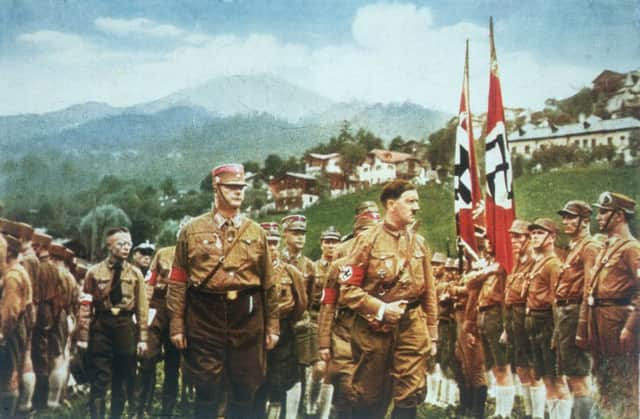Lori Anderson: Laughing at Hitler mat not be funny


‘Springtime for Hitler and Germany, winter for Poland and France.” If he were alive today, the Fuhrer would be clicking together the heels of his polished black leather boots to this eminently hummable show tune from Mel Brooks’ The Producers. Today, the most evil man of the 20th century is enjoying a surprising rehabilitation in Germany, where his popularity as a new figure of fun is rising with the crocuses.
A new satirical novel entitled Look Who’s Back (Er Ist Wieder Da) by Timur Vermes has sold 1.4 million copies in the former Third Reich at €19.33, a price designed as a nod to history. In the novel, Hitler wakes up in a Berlin building site in 2011 and is mistaken, first of all for an actor in a Second World War drama and later as a stand-up comic whose rants against Jews and Muslims become an instant YouTube hit: “What irritates me most of all about these morning people is their horribly good temper, as if they had been up for three hours and already conquered France.”
Advertisement
Hide AdAdvertisement
Hide AdMining the character and infernal accomplishments of Adolf Hitler for humour is a dangerous practice, with the roof liable to collapse on to the comedian, burying him or her in righteous condemnation. Yet Hitler was always a credible figure of fun; from the wild gesticulations of his impassioned speeches at Nuremberg to the carefully trimmed moustache, each element was ripe for mockery.
During his rise in the “dark valley” of the 1930s, political cartoonists in Britain lampooned his behaviour and in the US, the Three Stooges were the first film-makers to tackle his political might in You Nazty Spy, in which Moe played a Hitler-esque dictator almost a year before Charlie Chaplin unveiled his comic masterpiece The Great Dictator in 1940.
Looking back at Chaplin’s movie, his first and most successful “talkie”, he bravely tackles Hitler’s antisemitism by playing a Jewish character who becomes mistaken for the nation’s illustrious leader with one stroke of that iconic moustache.
Meanwhile, in Britain, there was a long comedic tradition of mocking one’s enemies that stretched back to the Scots 16th-century leisure pursuit of flyting, in which poets assaulted each other in a form of gladiatorial combat, with stanzas and couplets taking the place of mace and trident, each combatant cheered on by a delighted audience that included the king.
In Britain, it was not enough to defeat one’s enemies, it was also crucial to mock and diminish them, to smother them in laughter, which is why British troops marched to war chanting a ditty that revealed that the Fuhrer had “only got one ball”.
Comedy has always been an effective weapon of war. Laughter can diminish fear, and that can only aid one’s cause. Yet what place does it have in the post-war time of peace – can its application be a healing balm to trauma?
In 1949, four years after Hitler ordered Berlin to be razed to the ground, an accomplishment the Russians almost achieved, the residents of West Berlin trooped along to see a cabaret show called I Was Hitler’s Moustache, about the Fuhrer’s body double. Der Spiegel reported: “Hitler’s first step on to a Berlin stage was laughed at loudly and at length.” I imagine the laughter was one of relief that the national nightmare was over.
Since then, in a bid to deal with their national shame and prevent any resurgent rise of the far Right, Nazi paraphernalia such as Mein Kampf and the swastika flag were banned in Germany. So while in the 1960s Britain laughed along with Monty Python as John Cleese played a “Mr Hilter” now reduced to planning the invasion of Russia from an English boarding house, such laughs took a lot longer to be heard in Germany.
Advertisement
Hide AdAdvertisement
Hide AdA breakthrough came in 1998 when a German cartoon had Hitler in a gay relationship with Goering and working with the recently deceased Princess Diana to complete his foiled plans for world domination.
When extra3, a German comedy show, had Hitler appear in sketches, it initially provoked an outcry, but today complaints are more likely to be made about sketches involving animals and the Catholic Church.
Timur Vermes, the author of the new book, believes Germany has moved on from laughing at Hitler to laughing with him, which he believes is another way of comprehending the man behind the monster. As Vermes said in a recent interview: “First we tried not to mention him at all, then we made him into a monster. Then we poked fun at him. This is the next round.”
When it comes to humour about Hitler, I’m decidedly torn, for as much as I’ll laugh at the rewritten subtitled rants on YouTube that now accompany Bruno Gantz’s portrayal of him in Downfall, or smile at the Hitler house, there is a part of me that knows that each laugh is hollow and inevitably leads to the ovens of Auschwitz. Hitler and the Holocaust are inseparable and it is this crime, unique in human history, that makes me at times think Hitler should be the exception to the rule that says we can find humour in anything.
In one passage in Look Who’s Back, Hitler compares a man wielding a leaf-blowing machine to SS officers obeying orders: “Even though they could have easily complained, ‘What are we to do with all these Jews? It makes no sense any more; they’re being delivered faster than we can load them into the gas chambers!’”
Maybe it is because I recently watched Laurence Rees’s magisterial BBC documentary series Auschwitz: The Germans and the Final Solution, that there is a part of me which resists in this unique case what Mark Twain insisted was the very definition of humour: “Tragedy plus time.”